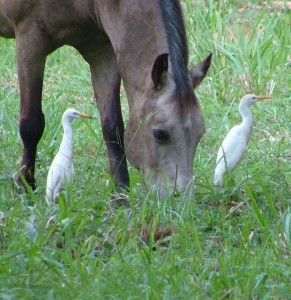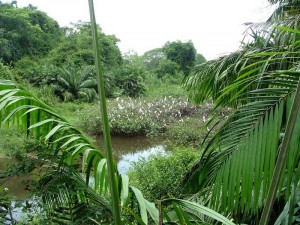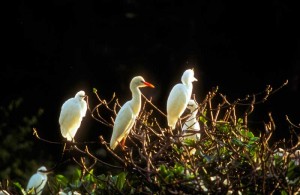Bird Watching in the Killing Field
By Jack Ewing

When the first settlers moved into the area around Dominical in the early 1900s, they found primary forests comprised of hundreds of thousands of species of living organisms. Over time trees were felled and the highly diverse forests replaced with several species of grass intended for the exclusive consumption of domestic animals which in turn would be slaughtered for human food. The ecosystem that evolved around this reality was much lower in biodiversity than the primary forest it had replaced. However, certain species that humans consider pests, such as vampire bats, ticks, lice, grasshoppers and rats, experienced population explosions; and, in the case of birds, the number of species increased significantly to include those that thrive in open spaces and near livestock.
At first glance it may seem strange that deforestation fomented an increase in the number of bird species. Had the rainforest been eliminated entirely, the number of bird species would certainly have decreased, but this was not the case. When I first visited Hacienda Barú in 1972, approximately half of the rainforest was undisturbed, about 170 hectares (420 acres.) The rest had been cleared and planted to pasture or crops. All of the rainforest species were still present. The new ones that migrated in as the forests diminished, required different conditions. The deforestation of Costa Rica generally began in the northwestern province of Guanacaste and spread southward. The migration of bird species that thrived in open areas with few trees followed.
Before Hacienda Baru started to cater to bird watchers and ecological tourists from all over the world we kept about 150 head of cattle and a dozen horses. These grazed in pastures that were fenced into sections that varied in size from two to ten hectares (five to twenty-five acres.) As anyone who has lived in the tropics will attest, weeds literally grow like weeds. Keeping unwanted vegetation under control is a constant chore. Clean pastures produce more beef than weedy ones. Some ranchers used herbicides, but I preferred mechanical methods. The most efficient method of cleaning lowland pastures is with a farm tractor and a mechanical mower called a “bush hog,” that chops or mows everything down to about 15 cm. (6 in.) Two or three times a year, after the livestock had completely grazed a pasture, we went in and chopped the area, leaving a weed-free pasture. At that time cleaning pastures with the mower was my favorite job. It was also my first experience in bird watching.

One morning, bright and early, I started up the tractor, hooked up the bush hog and headed out to a seven hectare (17 acre) pasture that was overdue for chopping and thick with undesirable grasses and brush. My son Chris rode on the fender of the tractor. We first cut a swath around the perimeter and then continued going round and round. With each circuit, the unchopped area diminished. About half-way through the second round, Chris tapped me on the shoulder and pointed to the sky in the direction of the mangrove estuary. “Look Daddy, here come the garzas.” A group of white cattle egrets was breaking out of their typical V-shaped flight formation and descending, ultimately flaring their wings to land in the newly cut vegetation near the tractor.
At the time, these were probably the most populous birds on Hacienda Barú. Their history is fascinating and relevant to our theme of deforestation resulting in increased diversity of bird species.
The cattle egret is native to Africa. Ornithologists speculate that the first ones to reach the Americas were blown across the Atlantic in a storm. Furthermore, they believe that this may have happened on several occasions, but prior to the late 1800s, conditions in the Americas were not favorable for the egrets. The first officially recorded sighting was in Surinam in the year 1877. By then there had been sufficient deforestation and creation of cattle ranches in South America to support a viable population of cattle egrets. As ranching expanded so did cattle egret populations. They were first recorded in Costa Rica in the year 1954 and today are found as far south as Argentina and as far north as the southern United States.
Why is deforestation and cattle ranching essential for the survival of cattle egrets? You need only observe feeding egrets for the answer to that question. The handsome white feathered birds with yellow beaks and legs stand about as high as your knee. Cattle and horses typically graze with heads down, moving slowly through a pasture and disturbing insects within the grass. Sharp-eyed egrets walk alongside, snatching grasshoppers, beatles and other large insects that flee the large animals scuffling hooves. If you pay close attention, you will notice that each egret defends a territory which consists of a two-meter (6 ft. 8 in.) swath around one cow or horse. On occasion I have seen egrets pick external parasites, such as ticks, from the hide of a resting cow. I have seen them feed on caterpillars that attack pasture grass. Experienced rice farmers know that if inch worms attack the young rice plants, there is no need to spray insecticides, because the egrets will soon come to feast on the pests.

Our tractor and bush hog didn’t move through the pasture on four legs, but it sure did stir up insects, and that’s what the garzas liked. It moved faster than livestock and the birds constantly took to flight, moving ahead of the machine and jockeying for position, rather than trying to defend a territory. There was plenty to eat for all. Again, I felt a tap on my shoulder. “Daddy, look up there, the bone-breaker just arrived.” Chris was refering to the crested caracara, named for its habit of carrying bones high into the air and droping them on a hard surface then landing to pick the nutritious marrow from within.
“Over there. Look at that rat. Uh oh, here comes a hawk.” The roadside hawk was dropping fast on a bee-line for the rat, flaring its wings at the last moment and extending its talons. But the rat dodged, changed directions and evaded the raptor. Out of nowhere the caracara plunged and snatched up the panicked rodent before you could blink an eye then carried its prize over to a cleanly chopped area near the trees and ate it. The bone-breaker preferred standing on the ground to an arboreal perch.
The roadside hawk lacked the skill to make a clean kill but instead, finished off rats, lizards and frogs that the egrets crippled but didn’t swallow. The egrets’ strong, straight beaks worked fine for snatching insects, but they have no way of chewing and swallowing larger prey. One would occasionally try to gulp a frog, but was quickly plagued by companions pulling on the amphibian’s legs, trying to steal a morsel. As larger prey fled the blades of the mower, the nearest garza usually delivered a powerful blow to the head with its sharp pointed beak and left the crippled animal for some lucky hawk or vulture.
As the work continued the freshly chopped area of pasture increased and the brush covered portion diminished. After a couple of hours an island of weedy pasture remained completely surrounded by a cleanly mowed swath several times its width. Straight ahead a large iguana made a break from the island. Egrets scattered, some taking to flight, as the large lizard barged through the flock and made a beeline to the trees at the edge of the pasture. Nothing intervened and the iguana safely reached its goal, a large poro tree where it took refuge in the upper branches. On the next round of the machine a tyra slipped silently and almost nonchalantly from the opposite side of the island. “Hey, look over there,” I nudged Chris’ leg. “There goes a tolomuco (the tyra’s Spanish common name.)” The black member of the weasel family, about twice the size of a large house cat, didn’t waste any time finding cover, but it certainly wasn’t frightened. None of the hungry predators present, other than the bush hog, was capable of harming it. Its self-assured attitude coupled with its agile body and sleek black coat captured my admiration and respect. The tolomuco turned slightly and looked back at us as it entered a brushy area at the edge of the pasture where we were working.
The hungry birds remained until the job was done. By then, both black-headed and the turkey vultures had arrived to pick through the aftermath. The bone-breaker joined them. Although this magnificent bird is an adept predator, having earlier demonstrated its ability by killing the rat, it is mainly a carrion eater and is often found feeding with the vultures. The large black birds generally defer to the smaller raptor. The following morning I saw a female coyote with two pups nosing around in the chopped vegetation hoping to find a morsel. In addition to the numerous small organisms that the egrets and hawks had eaten there remained much that had been killed by the machine. Land crabs were the most prevalent, but lizards, snakes and a few small mammals could be found as well. Within a couple of days nothing edible was left. The traces left uneaten by the carrion eaters was consumed by the ants. Nature leaves nothing to waste.
By this point you may be asking yourself, “What is the point of this gruesome tale of blood and guts? Surely Jack doesn’t expect us to emulate this example of wanton slaughter.”
All I can say is that in those days I made my living raising cattle, and clearing overgrown pastures was a necessary part of ranching. Experiences like this did help to spark my interest in tropical nature and influence my decision to convert Hacienda Barú into a refuge for wildlife of all kinds and a haven for ecological tourism and bird watching in Costa Rica. Additionally there are a number of lessons to be learned here.
- With only three or four months of overgrowth a weedy pasture becomes a haven for life of all kinds, from tiny insects to mammals. These species feed on one another and begin to develop a balance amongst themselves, the beginnings of an ecosystem. When we quit raising cattle on Hacienda Barú and allowed the pastures to return to their natural state, biodiversity increased rapidly and after more than 30 years harbors many times the number of life forms that existed in the overgrown pasture described above.
- Mother Nature recycles everything. All animals must eat. When one animal becomes injured or sick it is easy prey for one of the predators or scavengers described above. Every living thing on this planet sooner or later becomes food for some other living thing. In the case described above, human intervention created a “killing field” and a feeding frenzy for the meat eaters.
- The success story of the cattle egret illustrates the concept of the niche. Though these impressive white birds may have been blown across the Atlantic on many occasions, there was no niche for them and they failed to establish a viable population. Once humans began the process of deforestation and cattle production, the garzas found their niche, and as the niche expanded so did their populations. Cattle egrets originally evolved and found their niche in Africa, where humans also evolved, and the the bird’s success is closely tied to human activities.
Now that Hacienda Barú is a National Wildlife Refuge, 95% of the pastures have reverted to secondary forests, but the cattle egrets have not disappeared. They now come here to nest in the mangrove estuary, perhaps feeling shielded by the buffer of natural vegetation. Each day they fly out to feed in the two pastures where my wife has her horses and in the pastures and fields of neighboring farms. In the evening they return to the mangrove of the refuge to roost along with several other species of birds.
The cattle egret found its niche in this hemisphere and, in a little over a century, has spread throughout both American continents. The road side hawk, the crested caracara, rat, tyra, iguana, coyote, vultures and land crabs all occupy their niches. Without human intervention they, together with uncounted other organisms, will arrive at a state of dynamic equilibrium, constantly changing yet intricately balanced by the activities of infinite living organisms, each occupying its own special niche. I often wonder about the human niche. Exactly where do we fit in? Or do we simply run roughshod over every species that competes with us for food or gets in our way and appropriate all the niches we want? Maybe that’s why our planet is growing less hospitable. Maybe we should find our proper niche and learn to show respect for the millions of other species with which we share the planet. If not, I fear that Mother Nature may resort to more drastic methods of bring the Earth back into her bosom.

